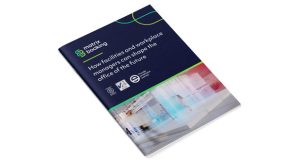A strategic approach to waste can reduce costs, increase recycling and even generate new income. Leading waste suppliers describe how they can help clients manage their waste more efficiently
NATHAN GRAY
HEAD OF SUSTAINABILITY,
HELISTRAT
Waste is a resource that can deliver real commercial, environmental and social benefits. It’s not just about doing what needs to be done or complying with the law. Companies need to consider the overall value good waste management can bring to the business. Waste is only rubbish when its value is neglected. That’s why we prefer the term ‘resource’.
By creating systems that segregate and capture different resource streams for recycling or repurposing, organisations can potentially gain a number of benefits. They can save on general waste removal costs, increase the rebates available from recycling and find new uses within the business for specific resource streams, all while contributing to sustainability or corporate social responsibility objectives.
We can conduct gap analyses to examine the way waste is currently being managed, and to identify any opportunities being missed. This might involve reviewing existing documentation such as waste transfer notes, analysing waste to see exactly what is being disposed of, and mapping waste flows. It might also include reviewing sustainability or CSR strategies to identify how new processes can help deliver on key targets, and exploring the ways employees are educated about proper resource management. You can have the right system in place, but if your people don’t understand why they’re being asked to do things differently, they’re less likely to cooperate.
Each organisation faces its own challenges, which is why every client requires its own bespoke waste management model. Helistrat’s models hinge on segregation – separating out the different resource streams is the key to optimising waste. Increasingly the quality of recyclable material is more important than quantity. Reprocessors are demanding higher standards of material, which we believe will lead to less co-mingled DMR (dry mixed recycling) and more segregated recycling going forward.
PAUL CRILLY
MANAGING DIRECTOR,
NJC
Every facility should have a waste strategy to maximise sustainability and corporate social responsibility, and comply with legislation relating to waste treatment. The most effective waste strategies are based on the concept of the waste hierarchy, with the aim of achieving a circular economy. The strategy must accommodate the physical limitations of the facilities, particularly available storage, which has a direct impact on collection frequencies (and therefore cost). It should also account for corporate sustainability strategies, plans and objectives.
The escalation in landfill taxes has incentivised businesses to reuse, recycle, compost, or recover energy from their waste. General waste is the most expensive to process, so sorting a building’s waste into discrete waste streams brings economic as well as environmental benefits. Reducing general waste and increasing dry mixed recyclables can offer substantial cost reductions or reinvestment opportunities. Further segregation into streams offers the opportunity to create commodities and generate income. Cardboard and paper are the most common, but recent media focus on plastics has increased their profile and accelerated the research and development of sustainable treatment.
The key to developing an effective strategy is measuring the waste stream volume as close to source as possible. Once the types and volumes of waste are known, equipment can be selected that will maximise onsite processing and disposal while minimising disruption. Equipment could include compactors, balers, food macerators and digesters, choice of which will be influenced by environmental conditions, storage space and access to transport. Other issues include potential contamination and bad smells arising from food waste stored on site. There is often a balancing act between onsite storage and collection, as transport costs add significantly to overall waste management costs.
A good supplier will develop a bespoke strategy to maximise recycling and minimise disposal within a legislatively compliant approach. At the Crown Estate’s flagship St James’ Mayfair development, operated on behalf of BNP Paribas, NJC engaged building occupiers, retailers and restaurants to win early buy-in to an innovative bag purchase strategy. This uses electric vehicle collections under a strict service level agreement for bag collections that aims to achieve clean streets.
Waste is segregated at source, with each waste stream weighed by NJC’s proprietary Waste Monitor system which allows collation of detailed waste data. This allows comparisons between individual users, and provides an opportunity for education where necessary. Waste is treated onsite, reducing the risk of contamination of separate streams; food waste is treated to reduce water content. The volume of waste is strictly controlled to minimise the frequency of collections, which delivers commercial and environmental benefits.
The waste strategy has resulted in zero waste to landfill, a significant increase in recycling, and a dramatic improvement in the appearance of the area.
GRAHAM SCOTT
HEAD OF BUSINESS DEVELOPMENT,
WCRS
Managing waste streams more effectively brings many benefits, including increased recycling rates, financial savings, and evidence of corporate social responsibility. Evaluating a waste management strategy, or testing the effectiveness of a waste management system, is important, and an independent waste audit is a good way to do it.
 The audit should first establish what you are trying to achieve. This could be to confirm compliance, determine the exact composition of waste, check the effectiveness of a recycling and waste management scheme, or all of the above. Next, the audit team needs to look at what is actually going on – how far company policy with respect to waste and recycling is being carried out. If mistakes are being made, it could be that staff are unaware of which items are recyclable.
The audit should first establish what you are trying to achieve. This could be to confirm compliance, determine the exact composition of waste, check the effectiveness of a recycling and waste management scheme, or all of the above. Next, the audit team needs to look at what is actually going on – how far company policy with respect to waste and recycling is being carried out. If mistakes are being made, it could be that staff are unaware of which items are recyclable.
If your waste is collected in a separate compactor or skip, you could request your waste management supplier to carry out an audit of the waste once it is returned to site, taking photographic evidence and producing a report. This will usually establish the composition of the waste and whether there is any contamination, although it won’t tell you where the waste is generated or disposed of. However, it may highlight where immediate improvements could be made, potentially saving money or increasing rebates for recycling.
It’s important that once conclusions have been reached, the facilities manager leading the project draws up an analysis and reports the findings, with recommendations for change. This should be disseminated widely. Ideally an audit shouldn’t be a one-off exercise; an organisation needs to regularly survey its waste output, in order to promote best practice and reach maximum efficiency.




